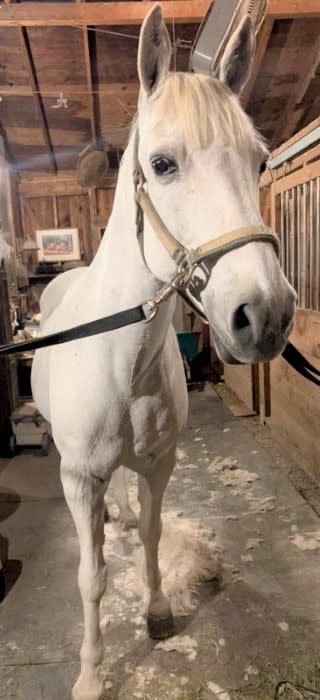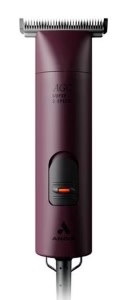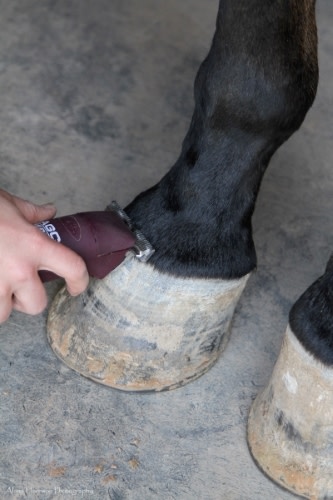Tips for Smart Body Clipping

A few years ago, my 22-year-old Arabian/Quarter Horse cross gelding Rolex was diagnosed with Cushing’s disease. Since then, I’ve body clipped him every spring, as he has a hard time shedding and therefore gets hot when the weather heats up. Since body clipping is a process (sometimes a long one), here are a few tips and tricks that can make the job easier on you and your horse. So, pull out those clippers and dust them off, because we’re jumping in!
Tip #1: Bathe First for Easy Clipping
Make sure to bathe your horse before body clipping. Even with daily grooming, dirt and dander can still be nestled under his coat. As you body clip, that dirt and dander will slow down the process and can even dull your blade. When I bathe Rolex before clipping him, I like to use a Jelly Scrubber to really work the shampoo into his coat before doing a final rinse. I find this really helps to remove any dirt and dander from his coat by going beneath the surface.
Once you’re done bathing your horse, you’ll want to make sure his coat is completely dry before clipping him. Rolex loves to roll after being bathed (he’s a typical gray), so I secure him in his stall with a quick-release knot and provide him with a slow-feed hay bag, while also making sure he has access to his water. If your horse is not a roller, you can just put him in his stall with hay and water until he’s completely dry. Better yet, if the weather is nice grazing your horse in the sun is a great way to help speed along the drying process!

Tip #2: How to Set Up Your Clipping Workspace
When your horse is almost done drying, go ahead and set up the space you plan to clip in. Before I start the clipping process, I like to go over Rolex with a curry comb and body brush to ensure I got all of the dirt and dander out of his coat through bathing him, so I set those out in my workspace. Next, I make sure I have plenty of coolant/clipper oil on hand for my blades. I use the Andis Cool Care Plus and can’t recommend it enough. It’s not just a lubricant; it’s a coolant as well, and who doesn’t love a two-in-one product!
Of course, we can’t forget to set out the star of the show—the clippers! I have the Andis AGC Super 2 Speed Clippers; while their purpose isn’t solely for body clipping, I really like these clippers because they’re quiet while also being a total powerhouse! Finally, I like to have an extra clipper blade (or two) on hand just in case I need to swap one out. By having everything on hand and laid out ahead of time, you’re ensuring the clipping process will run smoothly and efficiently.
Tip #3: Create a Clipping Game Plan
When you’re body clipping, you want to have a game plan. Are you planning on doing a trace clip? How about a hunter clip? Full body? Whatever kind of clip you’re doing, you need to plan where you’re going to start and where you’ll end up.

I like to start clipping Rolex in crossties, and when I start to see him become bored and antsy, I’ll put him in his stall for a few minutes to grab a drink of water and go to the bathroom (if needed). Following that, I will hook up my SmartPak Slow Feed Hay Bag from earlier and clip it to the top of one of the crossties. This way, I can keep him busy while I continue body clipping. Rolex is a laid-back guy, so this works for him, but I wouldn’t recommend doing this with any horse.
Keep in mind, after you begin clipping, you’ll start to see hair that’s been clipped accumulate on your horse’s coat. I like to periodically stop and use my body brush to sweep it off. By that time, I usually make sure to brush excess hair off my clipper blades (while they’re off). Then, I spray them down with the coolant (while running), because they’ll get hot as you clip—and hot clippers can lead to clipper burn. Before I resume clipping, I test the temperature of the blade by holding it up to the inside of my wrist. Once I’m sure it’s cool, I continue clipping and then repeat the above process over and over until I feel I’ve reached a good place to stop for the day.
Tip #4: When to Call it Quits
Just like people, horses can get bored and just simply over it. Rolex usually shows me he’s done being body clipped when he dances around even with hay in front of him. I usually gauge where we’re both at after a few hours of clipping; if Rolex seems like he’s done for the day, I find a good place to stop and finish things up the next day. When I’m done, I make sure to go over him with a good brush to remove any stray clipped hairs from his coat. If it’s hot out when you’re body clipping, it might be a good idea to give your horse a quick bath or spray down.

When you call it quits for the day or if you’re done with body clipping in general, consider the weather and how your horse’s coat (or lack thereof) will impact his body temperature. Will your horse need any clothing after you’re done body clipping? Since spring nights can be temperamental and are often cool, I usually put Rolex in a nylon sheet; I love the Big D Nylon Stable Sheet. If it’s still too cold, I throw a lightweight stable blanket on top of the nylon sheet.
Body clipping can be a very long process, but planning can help cut down on the length of time you and your horse are “tied up” (no pun intended). I hope these tips help you in your body clipping adventures.